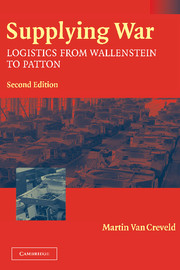Book contents
- Frontmatter
- Dedication
- Contents
- Maps
- Preface
- Introduction
- 1 The background of two centuries
- 2 'An army marches on its stomach!'
- 3 When demigods rode rails
- 4 The wheel that broke
- 5 Russian roulette
- 6 Sirte to Alamein
- 7 War of the accountants
- 8 Logistics in perspective
- Postscript: Where are we now?
- Note on sources
- Bibliography
- Notes
- Index
1 - The background of two centuries
Published online by Cambridge University Press: 22 June 2023
- Frontmatter
- Dedication
- Contents
- Maps
- Preface
- Introduction
- 1 The background of two centuries
- 2 'An army marches on its stomach!'
- 3 When demigods rode rails
- 4 The wheel that broke
- 5 Russian roulette
- 6 Sirte to Alamein
- 7 War of the accountants
- 8 Logistics in perspective
- Postscript: Where are we now?
- Note on sources
- Bibliography
- Notes
- Index
Summary
The tyranny of plunder
The period from 1560 to 1660 has been described as ‘the military revolution’ and as such was characterized above all by the immense growth in the size of Europe's armies. Marching to suppress the revolt of the Netherlands in 1567, the Duke of Alba made a tremendous impression by taking along just three terdos of 3,000 men each, plus 1,600 cavalry; a few decades later, the Spanish ‘Army of Flanders’ could be counted in tens of thousands. The most important engagements of the French Huguenot wars during the latter half of the sixteenth century were fought with perhaps 10,000-15,000 men on each side, but during the Thirty Years War battles between French, Imperial and Swedish armies numbering 30,000 men and more were not uncommon. At the peak of their military effort in 1631-2, Gustavus Adolphus and Wallenstein each commanded armies totalling far in excess of 100,000 men. Such numbers could not be sustained during the later stages of the Thirty Years War, but growth continued after about 1660. At Rocroi in 1643, the largest power of the time - Imperial Spain - was decisively defeated by just 22,000 French troops, but thirty years later Louis XIV mobilized 120,000 to deal with the Dutch. Even in peacetime under his reign, the French Army seldom fell below 150,000 men, that of the Habsburgs being only slightly smaller, numbering perhaps 140,000. The war establishment of both forces was much larger still, the French one reaching 400,000 during the years of peak military effort from 1691 to 1693. In 1709, it was already possible for 80,000 Frenchmen to meet 110,000 Allied troops on the battlefield of Malplaquet. More and better statistics could be adduced, but they would only serve to prove what is generally recognized: namely, that apart from a period of about twenty-five years between 1635 and 1660, Europe's armies a case it might become necessary to prevent the richer soldiers from buying up all the available stock for their own use. The system, as is well known, was subject to endless abuses that worked against the interests of almost everyone involved. Nevertheless, there was not in principle anything manifestly impossible about it.
- Type
- Chapter
- Information
- Supplying WarLogistics from Wallenstein to Patton, pp. 5 - 39Publisher: Cambridge University PressPrint publication year: 2004
- 1
- Cited by



